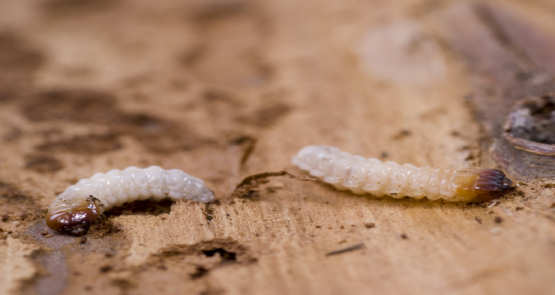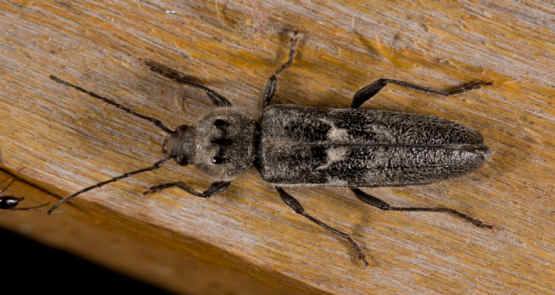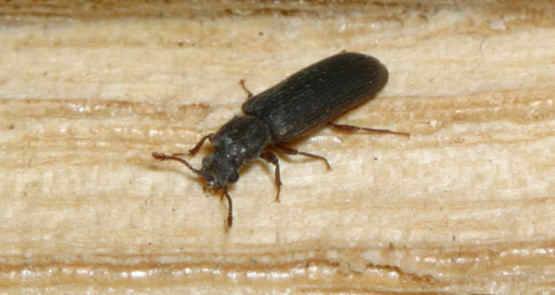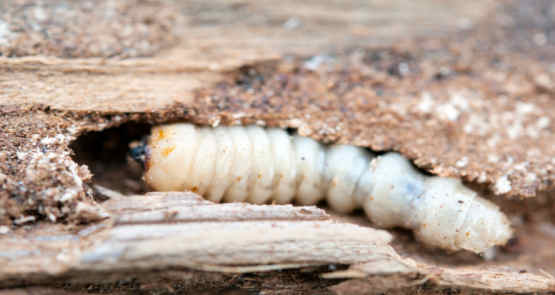Woodworm Treatment Service Covering Plymouth, Devon & Cornwall
The wood-boring beetle
Woodworm is a general word most commonly used by people to describe an insect infestation in their timber at home. They are actually wood-eating larvae a bit like maggots or caterpillars. There is a variety of wood boring beetle species making them sometimes hard to identify. They love warm temperatures and damp conditions and will thrive in this environment. Most commonly found in a building where there is not a great deal of ventilation in an enclosed area space such as in a roof space loft or under the floor or stairs. The adult female beetle lays her eggs on the timber and once hatched it’s the larvae who cause all the damage by tunneling into the wood so weakening its fabric and can lead to detrimental damage to structural timbers if infested within a building. A tell tale sign of an infestation is the presence of small holes in the timber. These holes can vary in sizes but usually there are found to be between 1.0mm to 1.5mm in diameter dependent on the species of infestation. If you notice in the summer months, adult beetles on the timber and fine wood dust around the holes it is likely to be an active infestation.
Actually the term 'woodworm' is a made up word to describe a number of different insect beetles in the infant maggot looking larval stage that eats wood. Not good for any building whatsoever.
The main species are:
- Common Furniture Beetle – This is the most commonly found woodworm accountable for approximately 75% of all attacks to a building timber
- Death Watch Beetle – Mainly found in older buildings such as churches or historical listed buildings as it prefers hardwood
- House Longhorn Beetle – The largest found and likes roofing timbers so found in loft areas and can cause a lot of damage due to their size
- Wood Boring Weevil – Prefers timber already under fungal attack thus double trouble for the wood in question
- Powder Post Beetle – A tricky little character and often causing lots of confusion more than other possible infestation pests. Mistaken diagnosis often leads to the wrong treatment being carried out and unnecessary expense being spent
They have four stages in their development:
- Egg – Adult beetles will lay their eggs in timber crevices, cracks and splits it finds such as flooring joists stairs etc. Because the eggs are so small they are easily missed so the infestation can spread very quickly
- Larva – The eggs then hatch and become larvae. These are very hard to see again but if spotted they are caterpillar or maggot like looking creatures which immediately begin to tunnel into the wood. Once inside the timber they can remain hidden for several years tunneling away slowly weakening the timber
- Pupa – As the larvae consumes the wood it grows until it reaches a size known as Pupa. The larvae will make their way to the surface of the timber when ready to pupate
- Adult Beetle – This is the final stage where the pupa emerges as an adult beetle, flies off to find a mate and the process begins again


Once the larva has reached maturity and become an adult it no longer feeds, it concentrates all its efforts into reproducing. When mating begins the female will lay her eggs where she can in cracks, crevices o even splits in wood. Then after three weeks the eggs hatch revealing small C shaped creamy coloured larvae about a millimeter long.
Two most common species of woodworm are:
- Common Furniture Beetle – Anobium Punctatum
- Deathwatch Beetle – Xestobium rufovillosum
Common furniture beetle
This is the most common beetle found. The larvae will make their way to the surface of the timber when ready to pupate. After pupation and they have transformed into a beetle they will break through the surface of the timber making little 2mm exit holes called 'flight holes' and leaving behind very fine wood dust called 'frass'. If there is frass or little piles of dust beneath each hole it is a good indication of an active infestation.
They only prefer seasoned sapwood timber in softwoods and hardwoods and do not attack the heartwood section timber from a tree. The Larvae can live for three to four years boring through the timber before pupation and becoming an adult beetle. The larvae can get up to 7mm long and the adult beetle can grow to approximately 4.5mm in length. In the first six to eight weeks it transforms from egg to larvae. It then feeds on the timber it was laid on for the next three years before it eventually pupates turns into a beetle, eats its way to fly out, finds a mate and the cycle begins again.
It is not fussy and will attack almost any wood whatsoever meaning your furniture and other household timber fabrics are at risk such as skirting, floorboards, stairs and balustrades. It attacks often are related to damp issues, a raised humidity and a lack of good ventilation. As said though it is not fussy, it will happily infest good ventilated dry areas such as roofing timbers or a suspended mezzanine floor. The attack may not be as severe but if left will be detrimental. Any infestation left for a long period of time will lead to the total destruction of all timber fabrics including your furniture. The adult beetle will lay her eggs around the same place where infection is already present.
Deathwatch beetle
The Deathwatch Beetle is very common and attacks structural timbers especially in older buildings such as churches or historical listed buildings as they usually contain hardwood being oak or elm. When the adult beetle wants attract a mate they make a unique tapping sound with their head that can be heard by people especially when conducting all night vigils in an old church so is how it got its name as the Death Watch Beetle.
They are only usually found in hardwood and often found in timber already infested with a fungal decay, especially elm or oak, but in doing so they are inflicting yet further damage on already fungal infested weakened timbers so sever damage to these timbers is usually imminent. However if softwood is in bedded in hardwood or in contact with hardwood in some way like flooring, it can also be at risk of attack. Timber prone to any damp is usually where it all starts such as wall plates, joists or sole plates.
The damage can look like a furniture beetle but their flight holes are slightly bigger at about 3mm wide. If left with extensive tunneling the damage can be significant. Replacement timbers are often required with after care periodic re treatments necessary because of the timber replacements and on large surface area timbers.
House longhorn beetle (Hylotrupes Bajulus)
The Longhorn Beetle is not a common infestation and located usually in the south east of the UK. Many reports have found it around Camberley in Surrey so it has also adopted the name 'Camberley Beetle' They have been found in other parts of the country due to infested cases used for transport has been relocated. It can usually be found within loft space areas and roof voids.
It particularly likes feeding on the sapwood of softwood timbers but will also attack heartwood. If left continuous internal tunneling by the larvae can lead to total disintegration of all sapwood leaving just a very thin crust layer to the outer surface of the timber. Often these timbers will usually require replacing. They are a considerable size bigger than the deathwatch beetle and the common furniture beetle as their flight holes are 6 to 10mm in diameter with at times ragged edges and they can grow up to 25mm in length. They are brown or black in colour with greyish hairs. They have two in number shiny black spots to their body rather like two big eyes. Their larvae tend to reach maturity in the spring and are a white grey colour, rather fleshy looking and can grow up to 35mm long when fully grown. The frass or bore dusts they leave behind are cream coloured sausage shaped pellets that have a gritty feeling when touched and especially when rubbed between the fingers.
Treatment requires application of a preservative paste with a deep penetrating action to seek out and eliminate the beetle infestation eradicating it. Nowadays it is prudent now to pre-treat any new roofing timbers so as to prevent an attack from the house longhorn beetle.
Wood boring weevil (Euophryum Confine / Pentarthrum Hutton)
This species is found all over the UK. It prefers rotten damp timbers and often it is accompanying cellar fungus or wet rot. As it likes timber already infested with a fungal decay it becomes a secondary problem for the timber by inflicting yet further damage on already fungal infested weakened timbers so sever damage to these timbers is usually imminent. Both Larvae and adults do the damage to the timber. Adult weevils are approximately between 2.5 and 5mm in length and their larvae can grow to 3mm. They produce 1mm in diameter flight holes that are ragged on the edges. Their frass or bore dust is very fine and of a gritty texture. They tunnel mainly by following the wood grain and a few tunnels do come to the surface.
Powder post beetle (Lyctus Brunneus)
The Powder Post Beetle only mainly attacks the sapwood in wide-pored hardwoods with high starch levels such as elm, obeche, ash and oak. It looks very much like the Common Furniture Beetle with the same size 2mm flight holes. You can often see it in plywood as the obeche core has been attacked. It is can also be found in hardwoods recently imported. It follows the grain when tunneling and it is quite common to find it in wood block flooring or parquet floors. This species of beetle needs timber with a high starch amount that is usually found in new timbers. As the timber ages the starch amounts decreases so an current active infestation wood die off naturally in and around the10 year period. This means that timbers around fifteen years old or older will not be an acceptable environment as the starch levels would be to low for them to survive.
Even though they have just a short life span the damage they can do is immense. Treatment is the same as the Common Furniture Beetle, however, it is recommended to use and apply a brush gel for a considerable size large infestation. It is most important to ascertain an early detection to any form of woodworm attack. Nine times out of ten you will see the damage than actually spot the beetles since all the larvae development and tunneling happens all below the surface of the timber and the only tell tale signs of an infestation are the flight holes and bore dust frass bored out by the adults as they leave the timber.
The first course of action is to correctly identify the species of beetle you are dealing with as the damage and signs are all very similar to the Common Furniture Beetle so it can be quite tricky to distinguish between the two. However, there is one way, Look at the bore dust or frass. If the frass is very fine talcum powder dust it will be a Powder Post Beetle. If the frass is gritty to feel between the fingers it is a Common Furniture Beetle.


Beetle & woodworm attack on timber
Insects such as the Anobium Punctatum better known as the Common Furniture Beetle or the Xestobium rufovillosum better known as the Deathwatch Beetle, make small holes in timber which are usually flight holes and when visually spotted it is common to mistake it as an active infestation when in reality the infestation is inactive and the timber usually completely solid.
A common mistake is to bang against the timber with your hand, fist or hammer and see falling bore dust left from a previous infestation. This dust can be present inside the timber for years without doing any harm whatsoever. As the timber is knocked banged or dislodged the falling dust is often mistaken as a new active infestation but it’s not always the case. As a rule the indication of infestation to old timbers should be viewed as normal.
Our recommended would not be to perform a blanketing treatment of all hardwood timbers within a property apart from any softwood usually located in loft roof areas that are easily accessible. When using modern timber treatment products, their use should only be to the actual area in question that has been confirmed as an active infestation. This is usually applied to softwoods or it can be applied to hardwoods where they adjoin onto softwood or if a hardwood contains an unusual amount of moisture content and rot usually where the timber is built into a masonry wall incorrectly with no wrap of DPM or damp proof membrane to protect it. Thatched roofs can also be treated but in doing so the use of water based non flammable materials are used.
Some species of beetles such as the Euophryum Confine or better known as The Wood Boring Weevil Beetle do not require any treatment whatsoever. Usually the larva of the beetle is the culprit causing all the damage but in this case it’s the adult beetle causing the damage. Simple eliminate the moisture source and let the timbers dry out will result in the infestation leaving by their own accord thus not needing to use any chemical treatment.
Another species of wood boring beetle such as the Ernobius mollis, or better known as The Bark Borer Beetle uses the bark as its food source. If active simply remove all the bark thus removing it’s food source so eliminating the infestation. They can also be mistaken as an active infestation calling for chemical treatment when in reality it’s inactive and historic.
How to identify an active infestation?
We all heard someone say they have woodworm. It is used generically as a beetle infestation term as the larva being wormed like usually creates all the damage. It is always essential to employ the services of an expert so as to obtain the correct diagnosis. We can assist you in covering many different species of wood boring beetle so we can make the correct identification of your problem.
There are a few methods available for us to use such as analyzing the size of the flight holes and bore dust or frass. Capturing an adult beetle, or reading the moisture content in the timber along with the present time, month and year we can usually piece it together.
Treating an active infestation
Once an active infestation of beetle is identified the sensible course of action is to isolate the area completely and carry out the suitable treatment diagnosed maintaining regular monitoring on a six month to yearly basis especially during the active seasons. This can vary depending on the species in question. However, as a general rule of thumb the months from March to July are for the Deathwatch Beetle species and to August or even September for the Furniture Beetle species.
In the UK historic listed building suffer the effects greatly from the Deathwatch Beetle as the beetles favorite food oak. Once infested to eradicate it can be a major task. The infestation is usually found in timber already suffering from rot or high moisture content.
Detection of infestation is only achievable by seeing the flight holes present; because of this the infestation has plenty of time to become well established before it is identified. Modern methods of timber treatment insecticides focus on breaking the beetles’ infestation cycle from larva to adult. So total eradication will be for a similar period of time. New emerging adults will still occur for a few years more depending on the species until complete eradication is achieved.
The Deathwatch Beetle cycle to fly out can be from 5 to 10 years but there have been cases of 20 years cycles being known. This is all dependable on the type of timber infested and its moisture content. The Common Furniture Beetle cycle to fly out is at present about 3 years but there have been cases of 5 years cycle being known.
Very few reports of the Deathwatch Beetle have been reported in Ireland and it is rarely found in Scotland. They have become well established in southern England but are also commonly found throughout the country and in Europe.
Surveying & diagnosis
As there are a number different woodworm species all having their own certain characteristics they need a treatment suitable for them defined by their characteristic behavior so control and the eventual total eradication of the infestation is possible.
As experienced surveyors, we can perform a tailor made survey to correctly identify the species of infestation you may be suffering from. If we find that the infestation is currently active an assessment can be calculated to Asses the potential damage that may have been inflicted to any timbers.
To confirm the exact species of infestation we will initiate a frass analysis so the infestation is correctly identified. Other contributing problems and factors will also be taken into consideration such as explanations as to why there are damp conditions and the location of the water ingress. Our full report will contain details for drying times allowed for timbers along with quotations for remedial works to replace any timbers if necessary to prevent further spread.
Some of the treatment solutions we provide:
- Eliminate all water ingress producing the damp environment
- Ventilation & damp proofing assessments & recommendations
- All infected rotten timbers taken out and renewed
- In situ treatment of timbers
- Treatment using the correct timber pastes, fungicidal sprays or dual-purpose insecticides with fungicide application
- Timber resin application repairs especially designed for sympathetic timber replacement in listed historical properties
- Perform a frass analysis to determine a wood boring beetle species
- Monitoring flight holes to determine current activity of any wood boring beetle infestation
Contact us for advice & help
If you suspect you have an infestation issue regarding woodworm its important to call us as soon as you can for us to perform a survey so as we can successfully identify the species as knowing the species will effect the treatment implicated. Some insect’s larva woodworm have a life span of actually 10 years to fly out where others can only be 10 months to fly out.
Treatments for woodworm
It is essential that once treatment begins none be missed so it is important to perform a thorough survey to make the correct identification and determine if it is active or not. Once we have identified the species our experienced surveyor will allocate the correct insecticide formula needed to eradicate the infestation as they bore through feeding on the timber.
Our professional technicians will apply this process. Some insects will only require a spray treatment where others could well need application of an insecticide get that has deep penetrating abilities. Once this is done we will then need to access what damage they have caused and how it can be repaired. All our work is covered by our long term guarantee for your piece of mind.
Repairing damaged timber caused by woodworm
Most of the time woodworm infestation is caught before any major structural repairs are necessary. However, this is not always the case and from time to time it is necessary to repair the effected structural timbers so as the buildings structural integrity maintains intact. Repairs can be from application of resin repair procedures or the complete timber being removed and replaced.
Tell tale signs for a woodworm infection
Wood bore dust under flight holes meaning an active infestation is present.
The tell tale most obvious sign is small round holes in the wood from where they have tunneled out to the surface and took flight. This is why they are called “flight holes” and when they leave and take flight its called “fly out“. Look for very fine dust gathering under each hole or around the area, this dust is from the boring and tunneling to get out. If you see any of these small holes in your flooring check its not been weakened to badly, act quickly and call us before the woodworm cause enough damage to collapses the floor completely.
Should woodworm Be treated?
Yes is the answer! If woodworm is left and ignored it will cause detrimental damage to the timber fabric of your home. It is of the upmost importance you get the infestation treat as soon as possible.
How is woodworm treated?
To ensure all woodworm is fully eradicated from your property it is advisable to hire the services of a professional and experienced regarding insect pest control so as the correct chemical insecticides are used correctly and safely. At the same time it may be a prudent idea to investigate any damp issues you may have within your property, as there may be risk of reinfection at a later date.
We can help you through every step of the way. Our team of experienced technicians can put right any affected structural timbers along with treating the complete surface area of the wood.
We begin by applying to the surface area of the timber a water-based insecticide. This works by targeting new adult beetles emerging to fly out, making them sterile and unable to breed, and any larvae hatching and entering the timber. The whole process usually takes around a day to complete and on completion we then will issue you with a 30-year guarantee against re-infestation to the affected area. Depending on the initial size of the infestation an electrical method can also be considered to attract and kill adult beetles prior to the breading.
Should we move out during the woodworm treatment?
Our clients often ask us if it is necessary to move out of their property whilst the insecticide treatment works are being carried out. The majority of times its not necessary for anyone to move out whilst woodworm treatment is taking place. However, we do recommend that the area be kept clear and no one enters into the area for at least 8 hours.
Because of this reason we offer a service to work with our customers in order to minimize disruption of the household by carrying out the treatments in a time that suits them such as when they are at work all day and not home for 8 hours.
If there are multiple areas in the property that require being treated we can apply treatment in stages to suit the clients needs and again minimize disruption to the household. The only reason we would suggest you vacate your home would be if your infestation was so serious your entire house required treatment and you requested us to carry out the works at one time. Then and only then we recommend you vacate the property for a day only.
Is the treatment Safe for Pets?
Family pets are always a worry in these circumstances. Our recommendations are to keep pets well away from the treatment area during treatment and for a day or to after treatment just to be safe than sorry as our insecticides are mixed with strong chemicals and if any overspray lands on a paw or the fur of your pet it may inflict injury to their health. This is also the reason why no one is permitted in the area during treatment and after treatment for a minimum of 8 hours.


Is the woodworm treatment guaranteed?
With experienced surveyors and technicians onboard who have eradicated woodworm for many years we are in a perfect position to help you and we are so confident after treatment we will issue you with a 30 year guarantee giving you piece of mind there will be no re-infestation to that area for that period of time. If you would like to know more about our guarantees please see our guarantees for more information.
How do I prevent woodworm?
Identification and Prevention is key in pest infestation control. Woodworm only attack sapwood from seasoned timbers they don’t touch live or fresh timber. Some totally dislike heartwood.
You can see this when looking at the infested areas you see an area with an abundance of holes and another area is untouched. This is because the timbers contain both sapwood and heartwood parts of the tree used.
Woodworm attack is very common in old timber framed houses that have not been treated. Diagnosis is noted when you see small round holes 1mm to 1.5mm in diameter and if below these holes there is a power fine pile of dust the chances are is active. As woodworm has a three-year life cycle the chances are you have had this infestation for a minimum of 3 years already. Wood bore dust under flight holes meaning an active infestation is already present.
How much is woodworm treatment going to cost me?
How much is that piece of string? What length wood you like it? What size gauge would you like it? What material do you want it made from? Would you like it in a ball or on a roll?
You see there are many factors in just purchasing a piece of string and alike each woodworm case will be different as all properties vary in size, design and shape. We need to conduct a tailor made survey especially designed for your properties requirements before we can give you a cost estimation for the works but ensure to help you and stay within your budget if possible
If you think you have a current problem and you are wanting a quotation please contact us as soon as you can and so we can arrange a survey to diagnose your issues, decide if timber repairs or treatment is necessary or not and advise you accordingly providing you with a quotation if necessary.
Upon completion of our survey you will receive a tailor made report with quotations only your individual property. It will include a detailed explanation of the treatment required to eradicate any infestation problem you may have.
Our Warranty/Guarantee
We are proud to say we take pride in our reputation and how we work. Upon completion of our works you will receive our personal workmanship warrantee along with our guarantee and a manufactures guarantee protected and backed up by the Guarantee Protection Insurance Scheme or (GPI).
We are also looking to become members of the Property Care Association, CHAS, Construction Line and Trust Mark for your peace of mind. All our warranty and guarantees are transferable to new owners of your home if you sell your property.
What lengths of guarantee do we offer?
- Basement water proofing treatments will receive a 10-year guarantee
- All Woodworm treatments, Dry Rot, Wet Rot and Rising Damp will receive a 30-year guarantee
- Timber unit and window treatments will receive a 5-year guarantee
- As an extra on request we can issue an independent insurance backed guarantee


Every case of damp is different and depending on the scale and size of the problem costs to repair will vary. It is important that you have your property surveyed and an individual and specific report completed as soon as possible. Our service gives each customer an individual report with recommendations and quotation to fix the damp problem. To make sure we are giving you an accurate price, one of our surveyors will come to your property to investigate the problem. Once your property has been assessed we will discuss the findings with you and detail the way forward.
Our services we supply in short:
- Damp proofing advice & support
- Damp Surveys
- Basement waterproofing
- Rising damp treatments
- Condensation treatments & control
- Woodworm Treatment
- Wet rot & dry rot treatments
Remember your property is at risk if you let damp set in and do nothing about it!
Please feel free to contact us for further advice
If you are concerned about any of the above issues affecting your property, please contact us and a member of our team will be happy to help, as we are Specialists in Property Surveying.



